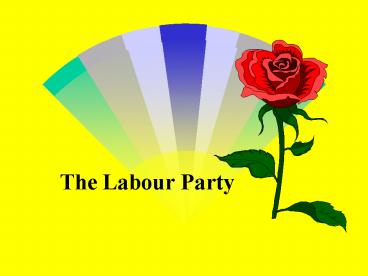The Labour Party - PowerPoint PPT Presentation
1 / 28
Title:
The Labour Party
Description:
Where the rights we enjoy reflect the duties we owe. And where we live together, freely, in a spirit of solidarity, tolerance and respect. ... – PowerPoint PPT presentation
Number of Views:1028
Avg rating:3.0/5.0
Title: The Labour Party
1
The Labour Party
2
- 1. Introduction
- 2. Origins
- 3. Old Labour
- 4.New Labour
- 5. Conclusion
3
1. Introduction
Blair Enters No. 10, 1997 en famille
4
2. Origins
- Some Trade Unions
- Two Political Parties (ILP SDF)
- A Socialist Society (The Fabians)
5
Keir Hardie Founder of the Labour Party and First
MP
6
Characteristics
- No individual members.
- Did not aspire to be a government.
- Began as an extra-parliamentary party.
- No division between voluntary and professional
side of the organisation. - Egalitarian and democratic ideology.
7
3. Old Labour
8
(a) Changes of 1918
- Individual Membership for the first time
- Adopted a Socialist Ideology
9
Clause 4 (iv)
- To secure for the producers by hand and brain,
the full fruits of their industry, and the most
equitable distribution thereof that may be
possible, upon the basis of the common ownership
of the means of production and the best
obtainable system of popular administration and
control of each industry and service.
10
Labour and the New Social Order
- National Minimum
- Democratic Control of Industry
- Revolution in National Finance
- The Surplus for the Common Good
11
Ramsay MacDonald First Labour Prime Minister
12
(b) National Executive Committee
- Leader Deputy Leader
- Treasurer
- 12 Trade Union Delegates
- 7 Constituency Delegates
- 5 Females
- 1 Socialist Societies Delegate
13
Clement Attlee Established the Welfare State,
1945-1951.
14
(c) The Annual Conference
- A Parliament of the Movement
- Dominated by the Trade Unions
- Subordinate position of the Leader
15
End of Conference NEC singing Auld Lang Syne
Ian Mikado, Left Wing NEC member Ron Hayward,
Gen. Sec. William Simpson, Chairman, NEC Outside
Transport House 1960s.
16
(d) Sub-United Kingdom Level
- The Constituencies
- Regional Parties- including the Scottish Council
of the Labour Party
17
4. New Labour
18
(a) Pressures for Reform
- From the left to empower the activists over the
parliamentary leadership - From the right to empower the parliamentary
leadership through direct appeals to ordinary
members
19
(b) Reforms from the Left, 1979-83
- Mandatory Re-Selection of MPs
- Election of Leader by an Electoral College
- Greater party control over the election manifesto
20
Michael Foot with wife. Led Labour to it biggest
defeat since 1918
21
(c)Reforms from the Right, post-1983
- Retention of electoral college, but increased
influence of ordinary members - Constituency delegates to NEC chosen by postal
ballot, and MPs excluded - Voting at Conference by Electoral College
- MPs chosen directly by ordinary members
- Use of Referendums
22
Reforms from the Right continued
- Affirmative Action re female representation
- Possibility of Black representation on NEC
- Clause 4 (iv) replaced by Aims and Values
- Increased power of the centre
- Changed character of the Conference
- Reforms continuing..
23
The Labour Party is a democratic socialist party.
It believes that by the strength of our common
endeavour we achieve more than we achieve alone,
so as to create for each of us the means to
realise our true potential and for all of us a
community in which power, wealth and opportunity
are in the hands of the many, not the few. Where
the rights we enjoy reflect the duties we owe.
And where we live together, freely, in a spirit
of solidarity, tolerance and respect.Clause 4
of the Labour Party constitution
24
Current Executive Committee
- Leader
- Deputy Leader
- Treasurer
- Young Labour (1)
- Soc. Soc (1)
- CLPs (6)
- Trade Unions (12)
- (General Secretary)
- Government (3)
- Euro Leader
- Labour Councillors (1)
- PLP/ELP (3)
25
Reforms from the Right Continued
- Changed Character of Conference
- Reduced Policy-Making Days (5-2)
- Main Policies not discussed every year
- Speeches by Experts etc. (not all party people)
- Closed briefings by Cabinet Ministers
- Detailed worked transferred to policy forums
26
(No Transcript)
27
(No Transcript)
28
5. Conclusions
- Demotion of Trade Union influence
- A weakening of activist influence
- Greater power to the Parliamentary Leadership
- Greater emphasis on individual membership
- Abandonment of ideological commitment
- Transition from a Movement to an Electoral
Machine































